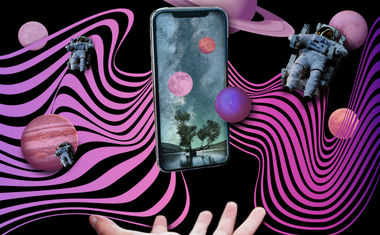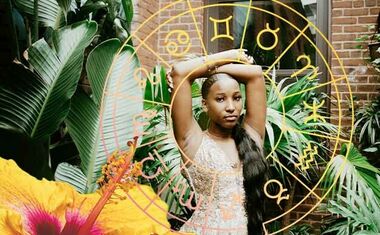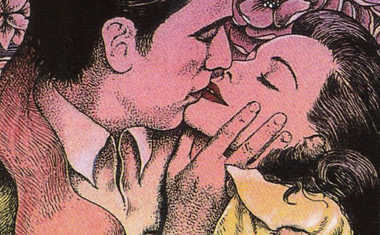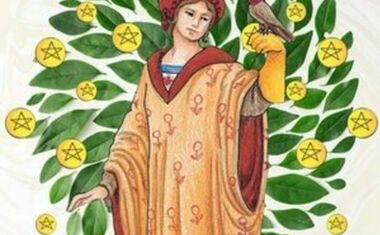
Iconology of the Heavens
From the Iconology Section of the Robert O'Neill Library
Introduction
Before we examine individually the iconology of the 16Star, 17Moon and 18Sun cards, it will be helpful to consider how the card-player would have viewed the Heavenly Spheres. In particular, it is important to realize that the card-player would likely have been familiar with images of the Heavens that incorporated all three of the Tarot symbols.
The cosmology of the late medieval world was a Christianized version of the concepts of Ptolemy of Alexandria (second century C.E.). Ptolemy, in turn, depended on Plato, Eudoxus (who devised the concentric spheres model) and Aristotle (Heninger 1977). In the early 15th century, when the Tarot was designed, the concept of the universe was geocentric, i.e., the earth was at the center. The model with the Sun as the center of rotation was only published by Copernicus in 1543. The Ptolemaic model is illustrated at www.admin.northpark.edu/dkoeller/Classes/Sources/Ptolemaic.html.
The basic idea was that the universe is composed of concentric spheres. Humans, being the sole purpose of creation, are found on the earth at the center of the universe. The planets and stars are confined to spheres which rotate around the earth. In the Christian concept, hell is at the center of the earth. Moving outward from the earth there are spheres representing the elements: water in the hydrosphere, air in the atmosphere, and then fire. Then come the spheres for the planets and then the stars. In some Christian versions, there would also be additional spheres for each of the 9 choirs of angels. Beyond the spheres is the domain of God. Between the realm of God and the furthest sphere of creation is a sphere called the Prime Mover, a Neoplatonic intermediary, designed to explain the transition between the unchanging and infinite God and the finite world of change and motion.
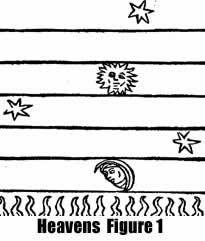 This cosmology may not have been known in detail by the card-player even though they may have been exposed to simple woodcut diagrams such as Figure 1 (~1349). More likely, the card-player would have thought in terms of a more general concept in which the star, moon and sun just represented "The Heavens". The more general concept is illustrated in a Parisian woodcut of 1542 (Fig. 2). Other instances of this type of general representation of the heavens are common. A similar image is seen in a 1488 woodcut from Venice (Hind 1935, p. 465). Figure 3 shows a woodcut from a 1512 edition of Ovid's Metamorphoses. Here we see the stars, moon and sun simply representing the heavens. All of these examples indicate that the card-player would have been associated star, moon and sun with the heavens.
This cosmology may not have been known in detail by the card-player even though they may have been exposed to simple woodcut diagrams such as Figure 1 (~1349). More likely, the card-player would have thought in terms of a more general concept in which the star, moon and sun just represented "The Heavens". The more general concept is illustrated in a Parisian woodcut of 1542 (Fig. 2). Other instances of this type of general representation of the heavens are common. A similar image is seen in a 1488 woodcut from Venice (Hind 1935, p. 465). Figure 3 shows a woodcut from a 1512 edition of Ovid's Metamorphoses. Here we see the stars, moon and sun simply representing the heavens. All of these examples indicate that the card-player would have been associated star, moon and sun with the heavens.
Panofsky (1939, fig. 51) shows a strange woodcut of Father Time from 1509 which shows a star and a sun on the spread wings and a crescent moon at the groin. This image suggests that the star, moon and sun might also have been thought of as representing the relentless onward movement of the heavens and their influence on our concept of time.
 One specific context in which the stars, moon and sun are used to represent the heavens is found in illustrations of the fourth day of creation: : "Let there be lights in the vault of heaven to divide day from night...God made the two great lights: the greater light to govern the day, the smaller light to govern the night, and the stars." (Genesis 1:14-16). Figure 4 shows a 1493 woodcut that was used as an illustration of this verse. The figure shows the influence of the Ptolemaic model of the universe. A similar image (Fig. 5) is found in an English bible from 1535. Here again the Ptolemaic model is suggested, but without any real adherence to details.
One specific context in which the stars, moon and sun are used to represent the heavens is found in illustrations of the fourth day of creation: : "Let there be lights in the vault of heaven to divide day from night...God made the two great lights: the greater light to govern the day, the smaller light to govern the night, and the stars." (Genesis 1:14-16). Figure 4 shows a 1493 woodcut that was used as an illustration of this verse. The figure shows the influence of the Ptolemaic model of the universe. A similar image (Fig. 5) is found in an English bible from 1535. Here again the Ptolemaic model is suggested, but without any real adherence to details.
Apocalyptic tradition
Taken together, figures 1-5 indicate that the star, moon and sun were used to represent the heavens within the cosmological concepts of the time. But in the milieu of the early card-player, this representation of the universe would have been combined with images from John's Revelations, familiar from sermons and religious art.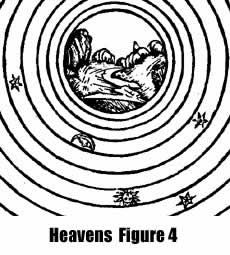
 Figure 6 shows a 14th century representation of the the most relevant verse, Revelations 8: 12: "The fourth angel blew his trumpet, and a third of the sun and a third of the moon and a third of the stars were blasted..." A similar image can be found in van der Meer (1978, p. 216). In both the verse from Revelations and in the illustration, all three of the Heavenly bodies are combined into one image.
Figure 6 shows a 14th century representation of the the most relevant verse, Revelations 8: 12: "The fourth angel blew his trumpet, and a third of the sun and a third of the moon and a third of the stars were blasted..." A similar image can be found in van der Meer (1978, p. 216). In both the verse from Revelations and in the illustration, all three of the Heavenly bodies are combined into one image.
Although illustrations of Revelations 8:12, such as figure 7 from ~1400, were the most common images in which the three heavenly bodies appear together, they are not the only examples. A Durer woodcut of 1498 (van der Meer 1978, fig. 190) shows the sun with straight and curved rays, crescent moon with face, and stars falling. The 13th century Douce Apocalypse (Hassell 1961, plate 4) shows the sun and moon in the sky. Figure 8 shows an illustration from ~1400 which was intended as a representation of Revelations 6. In many other examples of the apocalytic artistic tradition, the heavens overhead are adorned with stars, moon and sun.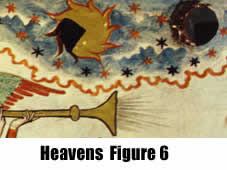
There is, of course, another section of John's book that mentions all three of the heavenly bodies. This is Revelations 12:1: "...a woman clothed with the sun, standing on the moon, and with the 12 stars on her head for a crown." We discussed this verse as possibly related to the Empress card. We bring it up again here because of the association of the three heavenly bodies into a single symbolic image. The image from Revelations 12:1 influenced other religious art, for example, a Madonna of 1428 shows the moon and sun in the background (Hind 1935, p. 165).
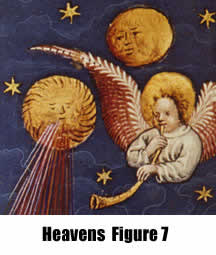 I also want to point out a related image in Petrarch. In the Triumph of Love, Petrarch indicates that his beloved Laura escapes entrapment by Love:
I also want to point out a related image in Petrarch. In the Triumph of Love, Petrarch indicates that his beloved Laura escapes entrapment by Love:
"No one can bind her with the bonds of love: ...Her smile, her words, and even her disdain, Make her, in truth, a sun among the stars."
It is debatable whether this is a conscious reference to the Lady in Revelations. But the brief passage does establish that the poetic imagery of sun and stars was part of the artistic milieu in which the Tarot appeared.
Finally, I want to call special attention to an illustration in Marshall (2000, plate 4). The image is a general representation of the final times, the Last Judgment, with imagery taken from various parts of Revelations. I mention the image here for three reasons. First, it shows the sun and moon in the sky. Thus, this is another example combining these images into a general concept of the Heavens. Second, the image is a processional banner of ~1471 from Perugia. This is the type of representation that the card-player was likely to have seen. Third, this is the processional banner of the Confraternity of San Benedetto dei Frustati. Thus, once again we seen the imagery of the early Tarot appearing in association with the confraternities.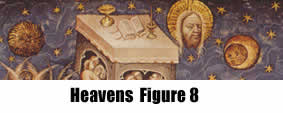
Interpretation
It seems reasonable to conclude that the card-players would have recognized the Star, Moon, and Sun cards as a representation of the Heavens, or the Cosmos. However, the cards are not in the proper cosmological order. In the Ptolemaic model, the order should be moon, sun, and then stars. This argues against these cards being simply a cosmological reference.
Perhaps the card-reader would have recognized that the sequence represents increasing light, i.e., enlightenment. The card-player would at least have been familiar with Dante whose "Divine Comedy" represents the ascent from Hell to Heaven as a journey of increasing light. So the sequential numbering of the star, moon, and sun, consistent in all 15/16th century variations, might have conveyed an element of hope and inspiration.
